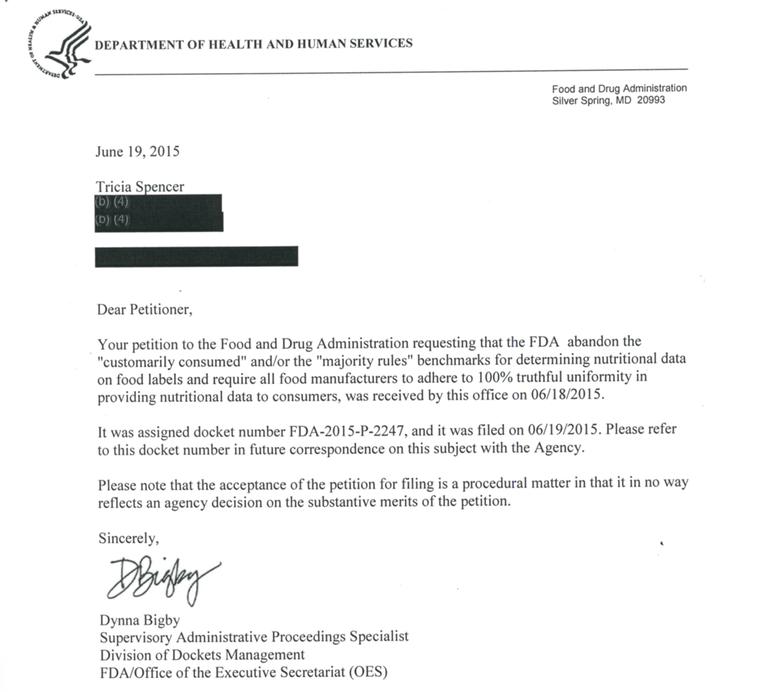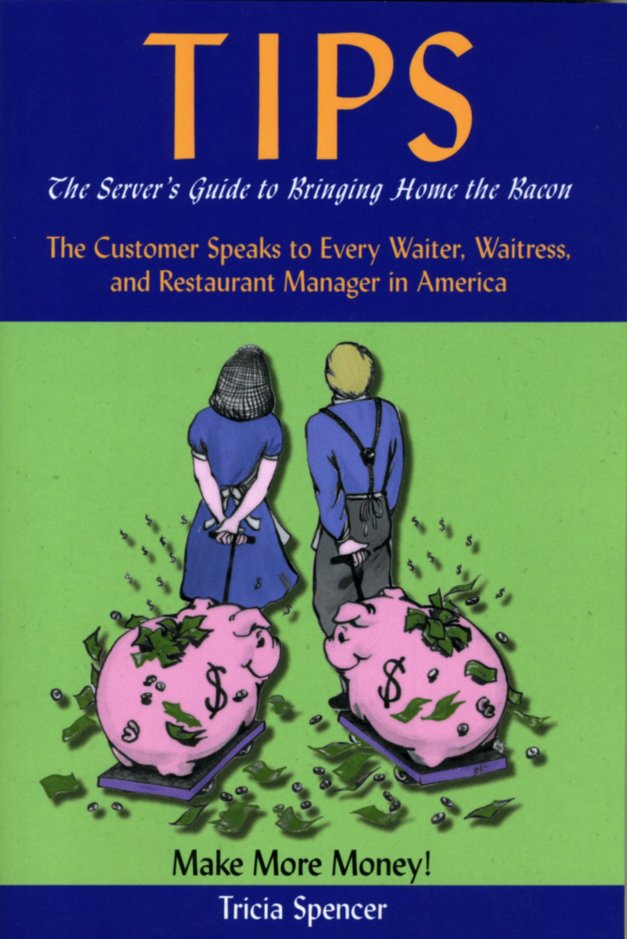FDA Citizen Petition
by Tricia Spencer
Dockets Management
Division of Dockets Management
Food and Drug Administration
5630 Fishers Lane
Room 1061, HFA-305
Rockville, MD 20852
UNITED STATES DEPARTMENT OF HEALTH AND HUMAN SERVICES
FOOD AND DRUG ADMINISTRATION
CITIZEN PETITION
Petition to Require Food Manufacturers to List Nutritional Data
for Every Edible Component, Including Liquid, in a Food Container
Submitted by
Tricia Spencer
June 12, 2015
Citizen Petition
A. Actions Requested
B. Statement of Grounds
1) "Customarily Consumed" - "Food Consumption Data"
Examples of Consumption of Liquids in Packaged Foods
Actual reviews left on AMAZON.COM for canned sardines
(bold emphasis and enlarged font added by petitioner, but comments unedited)
Will be buying more
By Eric on July 8, 2014
Verified Purchase
I hope its ok to eat everything inside, cause I did, including the olive oil. Delicious!
Very good
By M. Shapiro on May 30, 2014
Verified Purchase
Boneless and skinless. Unfortunately the price as of 5/29/2014 has increased by 50% - this in just 2 months! The olive oil tasted good and seemed like the real thing.
yum!
By Lily on April 10, 2014
Verified Purchase
This is something I will order again. The sardines are tasty and not too salty. There is a lot more olive oil than I expected, however, which is great that I would eat it with some bagels and avocado.
Wonderful
By E. K. B. "eblunt777" on January 10, 2014
Verified Purchase
They are much different from the 'cheap' counterparts. If you are trying to eat for health reasons, and the idea of a canned fish scares you, try this. Look at local store before committing to a dozen. The combo of no bones and olive oil make it more antipasto than seaside carnage
I like then a lot, no bones
By mikescooling "book-worm"on October 16, 2012
Verified Purchase
I like it that these are bone less. They come in olive oil and that is good too. I was hunting with friends and we had crackers and these; I smashed them into the oil and made a past to serve on the crackers, uummm it was so good...
Following is a recipe incorporating the oil from canned sardines
from Chef Alton Brown of the Food Network
(bold emphasis and enlarged font added by petitioner)
Sherried Sardine Toast
Recipe courtesy of Alton Brown
SHOW:
Good Eats
EPISODE:
Live and Let Diet
Total Time:
20 min
Prep:
15 min
Cook:
5 min
Yield:
4 servings
Level:
Easy
Next Recipe
Sherried Sardine Toast
(02:36)
Sardines scare you? Alton's Sherried Sardine Toast will change all that.
Ingredients
2 (3.75-ounce 2-layer) tins brisling sardines in olive oil
2 tablespoons finely chopped parsley leaves, divided
1 tablespoon sherry vinegar
1/4 teaspoon lemon zest, reserve the lemon and cut into 4 wedges
Freshly ground black pepper
4 (1/2-inch) thick slices crusty bread, such as sourdough, country loaf or rye
1 ripe Hass avocado
Coarse sea salt
Directions
Drain the oil from 1 tin of sardines into a small bowl and set aside. Drain the oil from the other tin into another small bowl and whisk in 1 tablespoon of parsley, vinegar, lemon zest, and black pepper, to taste. Add the sardines, stir to combine and set aside for up to 1 hour.
After 45 minutes, put a rack 3-inches from the broiler and heat the oven to the broiler setting on high. Brush each slice of bread on 1 side with the reserved oil. Put the bread, oil side up, onto a cooling rack set inside a half sheet pan and broil 2 to 3 minutes or until golden brown and crisp.
Halve the avocado and remove the pit. Smash the flesh in each half with a fork.
Spread the avocado evenly onto the toasted bread. Top evenly with the sardines. Pour any remaining dressing on top and garnish with the remaining parsley.
Season lightly with sea salt and serve with lemon wedges.
Recipe courtesy Alton Brown, 2009
Below is a recipe incorporating the juice in canned fruits from country music star Trisha Yearwood, featured on the Food Network
Easy Peach Cobbler
Recipe courtesy of Trisha Yearwood
SHOW:
Trisha's Southern Kitchen
EPISODE:
Family Fish Fry
Total Time:
1 hr 30 min
Prep:
10 min
Inactive:
20 min
Cook:
1 hr
Yield:
8 servings
Level:
Easy
Next Recipe
Easy Georgia Peach Cobbler
(03:15)
Trisha brings a touch of Georgia to Oklahoma with her Easy Peach Cobbler.
Ingredients
Two 15-ounce cans sliced peaches in syrup
1/2 cup (1 stick) butter
1 cup self-rising flour
1 cup sugar
1 cup milk
Homemade Whipped Cream, recipe follows
Cook's Note: If you don't have self-rising flour, substitute 1 cup all-purpose flour mixed with 1 1/2 teaspoons baking powder and 1/8 teaspoon salt
Homemade Whipped Cream:
2 cups whipping cream, chilled in the fridge
4 tablespoons sugar
Directions
Preheat the oven to 350 degrees F.
Drain 1 can of peaches; reserve the syrup from the other. Place the butter in a 9- by 12-inch ovenproof baking dish. Heat the butter on the stove or in the oven until it's melted. In a medium bowl, mix the flour and sugar. Stir in the milk and the reserved syrup. Pour the batter over the melted butter in the baking dish. Arrange the peaches over the batter. Bake for 1 hour. The cobbler is done when the batter rises around the peaches and the crust is thick and golden brown. Serve warm with fresh whipped cream
Homemade Whipped Cream:
Chill a large metal mixing bowl and the wire beater attachment in the freezer for about 20 minutes. Pour the chilled cream and sugar into the cold mixing bowl and beat until it forms soft peaks, about 5 minutes. The mixture should hold its shape when dropped from a spoon. Don't overbeat or you'll have sweetened butter! Yield: 4 cups.
Recipe adapted from Georgia Cooking in an Oklahoma Kitchen by Trisha Yearwood (c) Clarkson Potter 2008
The following recipe advocating the use of pickle juice, is from
Ted Wietrzykowski, Polish Village Café, as seen on the Food Network
Dill Pickle Soup
Recipe courtesy Ted Wietrzykowski, Polish Village Cafe
SHOW:
Diners, Drive-Ins and Dives
EPISODE:
Old to New
Total Time:
45 min
Prep:
15 min
Cook:
30 min
Yield:
8 servings
Level:
Easy
Next Recipe
Ingredients
5 tablespoons butter or margarine
5 medium carrots, shredded
2 large potatoes, cubed (about 2 cups)
3 large dill pickles, shredded
1 cup flour
1 cup sour cream
Salt
Pickle juice
Directions
Combine 5 cups water, the butter, the carrots and potatoes in a saucepan. Bring to a boil and cook until the potatoes are tender. Add the pickles and continue to boil.
Meanwhile, whisk together the flour, sour cream and salt in a separate bowl. Add enough water to make a paste, then slowly, to avoid curdling, add the mixture to the soup to thicken. Bring to a boil, then remove from the heat. Add pickle juice, to taste.
This recipe was provided by a chef, restaurant or culinary professional and may have been scaled down from a bulk recipe. The Food Network Kitchens chefs have not tested this recipe, in the proportions indicated, and therefore, we cannot make any representation as to the results.
Recipe courtesy Ted Wietrzykowski, Polish Village Cafe
Finally, below are two of many dessert, breads, and other recipes that come directly from DOLE®, a packaged food manufacturer, advocating the use of the liquid from their canned fruit in the recipe
Glazed Orange Rose Cake
Prep Time 10 minutes
Total Time 1 hours
Difficulty 1.0 Easy
Calories: Per Servings 320 Calories
Servings 12
Nutrition facts
About
This cake can be baked in this special rose cake pan for a fun presentation or in a regular bundt pan. Either way it is a great orange flavored cake that friends and family will enjoy!
Ingredients 6
Ingredients:
1 can (15 oz.) DOLE® Mandarin Oranges
1 box (2 layer) yellow cake mix
3 eggs
1/2 cup vegetable oil
1 orange, peel grated and juice reserved (optional)
1 cup powdered sugar
STEP 1
Direction
Preheat oven to 350F. Spray rose shaped bundt pan with cooking spray for baking with flour, or flour and grease pan. Drain mandarin oranges; reserve juice.
STEP 2
Direction
Combine cake mix, juice from can, eggs, oil, and orange peel in a large bowl; beat 2 minutes. Pour 1/3 batter in prepared pan; layer half of mandarin orange slices. Pour another 1/3 cake batter into pan; layer with remaining oranges. Pour remaining cake batter into pan.
STEP 3
Direction
Bake 40 to 45 minutes or until toothpick inserted in center comes out clean. Cool in pan 20 minutes. Remove from pan onto wire rack; cool completely.
STEP 4
Ingredients:
1 orange, peel grated and juice reserved, optional
1 cup powdered sugar
Direction
Combine juice from orange and powdered sugar in a small bowl; whisk until well blended. Gently brush glaze all over cake with pastry brush.
Hawaiian Bread
Prep Time 1 hours
Total Time 1 hours
Difficulty 2.0 Medium
Calories Per Servings 280 Calories
Servings 12
Nutrition facts
About
A great bread to serve at brunch.
Ingredients 7
STEP 1
Direction
Preheat oven to 350°F.
STEP 2
Ingredients:
1/2 cup sugar
1/4 cup butter or margarine, softened
2 eggs
1 can (8 oz.) DOLE® Crushed Pineapple, undrained
1/3 cup chopped macadamia nuts or walnuts
1 cup flaked coconut, divided
2 cups prepared baking mix
Direction
Cream sugar and butter in large bowl. Add eggs one at a time; beat well. Add undrained pineapple, nuts and 1/2 cup coconut and mix well. Stir in baking mix until just blended.
STEP3
Ingredients
Vegetable cooking spray
Direction
Pour batter into 9 x 5-inch loaf pan, sprayed with vegetable cooking spray. Sprinkle and lightly press remaining 1/2 cup coconut into top of cake.
STEP4
Direction
Bake 50 minutes or until top is golden brown or wooden pick inserted in center comes out clean.
STEP5
Direction
Cool in pan 10 minutes; remove from pan and cool slightly on wire rack. Serve warm.
Discussion: "Customarily Consumed" - "Food Consumption Data"
The above reviews and recipes are just a small sampling of easily discovered examples that call for utilizing the liquids from packaged products. If a recipe by a respected chef, or one obtained from a family member or friend, is followed, but the nutritional information on the can or jar does not reflect any data for the liquid in the container, determining the nutritional impact of the completed recipe is impossible. The outcome is harmful. Any excuse for omitting the information is unacceptable.
Whether or not DOLE voluntarily chooses to provide nutritional information for the liquid in their packaged foods is irrelevant if their competitors make the opposite choice. Could the above DOLE recipes be made using fruit from other manufacturers? Of course. But if there is no uniformity in the nutritional labeling from manufacturer to manufacturer, the consumer is denied a true and complete nutritional disclosure, resulting in false calories and nutritional impact of a finished recipe. Is this beneficial to consumers? No. Does it contribute to obesity? Absolutely. Simply consuming the oil in a can of sardines 5 times a week, without the knowledge that the oil has not been included in the calorie count, can produce a weight gain of nearly 10 pounds in a single year. Multiply that by the consumption of several products with undisclosed nutritional data, and it's apparent just how harmful the FDA's current nutrition labeling caveats are to public health and well-being.
2) Uniformity in Nutritional Labeling
The Food and Drug Administration's permission to companies to conduct themselves in such manner is
the root of the problem.
Viable Labeling Solutions
1) THE BEST SOLUTION: Absolute truthful requirement.
2) THE SECOND-BEST SOLUTION: Dual labeling.
3) THE LEAST-BEST SOLUTION: A highly visible disclaimer.
No Financial Harm to Manufacturers in Testing
Discussion: Uniformity in Nutritional Labeling
C. CONCLUSION
E. Environmental Impact
The actions requested are subject to categorical exclusion and do not require preparation of an environmental assessment.
F. Economic Impact
No statement of the economic impact of the request actions is presented because none has been requested by the Commissioner.
D. Certification
Respectfully submitted,
(s)
Tricia Spencer
Docket # FDA-2015-P-2247
Or visit regulations.gov and enter the docket # in the search box. When the petition comes up, click the blue COMMENT NOW! button to leave your comment.
Every comment matters! Thank you!
Or visit regulations.gov and enter the docket # into the search box. When the petition comes up, click the blue button to leave your comment.
Every comment matters! Thank you!
Note: Petition can be downloaded from the regulations.gov web site.
Note: Petition can be downloaded from the regulations.gov web site.
Petition Confirmation Letter from FDA:
Note: Because they were added after submission, before filing, Sections E and F appear out of order in the petition
 | ||||||













